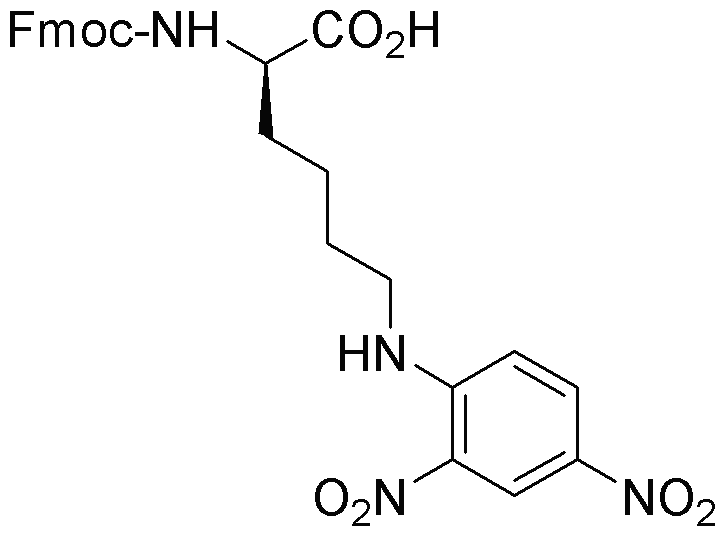Fmoc-Ne-2,4-dinitrophenyl-D-lysine is widely utilized in research focused on:
- Peptide Synthesis: This compound serves as a key building block in the synthesis of peptides, allowing researchers to create specific sequences for various biological studies.
- Drug Development: It plays a crucial role in the development of new pharmaceuticals, particularly in the design of peptide-based drugs that target specific diseases.
- Bioconjugation: The compound is used in bioconjugation techniques, enabling the attachment of drugs or labels to biomolecules, which is essential for drug delivery systems and diagnostic applications.
- Research in Immunology: It aids in the study of immune responses by serving as a hapten in immunological assays, helping to understand antibody interactions.
- Analytical Chemistry: This chemical is utilized in analytical methods for detecting and quantifying peptides, providing valuable data for researchers in various fields.
General Information
Properties
Safety and Regulations
Applications
Fmoc-Ne-2,4-dinitrophenyl-D-lysine is widely utilized in research focused on:
- Peptide Synthesis: This compound serves as a key building block in the synthesis of peptides, allowing researchers to create specific sequences for various biological studies.
- Drug Development: It plays a crucial role in the development of new pharmaceuticals, particularly in the design of peptide-based drugs that target specific diseases.
- Bioconjugation: The compound is used in bioconjugation techniques, enabling the attachment of drugs or labels to biomolecules, which is essential for drug delivery systems and diagnostic applications.
- Research in Immunology: It aids in the study of immune responses by serving as a hapten in immunological assays, helping to understand antibody interactions.
- Analytical Chemistry: This chemical is utilized in analytical methods for detecting and quantifying peptides, providing valuable data for researchers in various fields.
Documents
Safety Data Sheets (SDS)
The SDS provides comprehensive safety information on handling, storage, and disposal of the product.
Product Specification (PS)
The PS provides a comprehensive breakdown of the product’s properties, including chemical composition, physical state, purity, and storage requirements. It also details acceptable quality ranges and the product's intended applications.
Certificates of Analysis (COA)
Search for Certificates of Analysis (COA) by entering the products Lot Number. Lot and Batch Numbers can be found on a product’s label following the words ‘Lot’ or ‘Batch’.
*Catalog Number
*Lot Number
Certificates Of Origin (COO)
This COO confirms the country where the product was manufactured, and also details the materials and components used in it and whether it is derived from natural, synthetic, or other specific sources. This certificate may be required for customs, trade, and regulatory compliance.
*Catalog Number
*Lot Number
Safety Data Sheets (SDS)
The SDS provides comprehensive safety information on handling, storage, and disposal of the product.
DownloadProduct Specification (PS)
The PS provides a comprehensive breakdown of the product’s properties, including chemical composition, physical state, purity, and storage requirements. It also details acceptable quality ranges and the product's intended applications.
DownloadCertificates of Analysis (COA)
Search for Certificates of Analysis (COA) by entering the products Lot Number. Lot and Batch Numbers can be found on a product’s label following the words ‘Lot’ or ‘Batch’.
*Catalog Number
*Lot Number
Certificates Of Origin (COO)
This COO confirms the country where the product was manufactured, and also details the materials and components used in it and whether it is derived from natural, synthetic, or other specific sources. This certificate may be required for customs, trade, and regulatory compliance.


